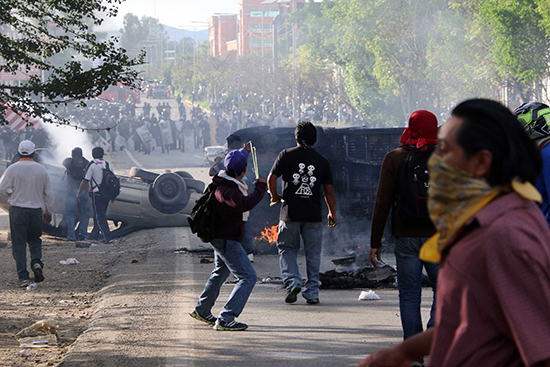Oaxaca, Mexico, June 21, 2016 — Mexican federal authorities should thoroughly investigate the case of a journalist killed on Sunday in the southern state of Oaxaca while covering protests, establish a motive, and bring all those responsible to justice, the Committee to Protect Journalists said today.
Elidio Ramos Zárate, a reporter for regional daily newspaper El Sur, was shot in the head by two unknown assailants driving a motorcycle, according to media reports. Authorities found Ramos Zárate’s body at a restaurant at approximately 4.00 P.M. with a fatal gunshot wound in the neck. A 9-millimeter bullet case was found on the scene. According to media reports, Ramos Zárate was eating there with Raúl Cano López, the brother of the owner of Punto Crítico, another regional newspaper. Cano López was also killed in the attack, and it remains unclear whether he was targeted.
The attack happened shortly after Ramos Zárate had finished reporting on several blockades and buses set on fire by teachers protesting in the city of Juchitán. The teachers’ union recently set up a series of blockades and protest marches across Oaxaca and other states to oppose changes to educational policy. In some places police have forcibly dispersed the protesters.
The day before the killing, masked men at the protest had threatened Ramos Zárate and other reporters, El Sur‘s editor, Luciano Pacheco, told CPJ. A spokesperson for El Sur told the Mexican news website Animal Politico that the men threatened the reporters not to document acts of violence.
“We call on Mexican federal authorities to bring all those responsible for the killing of Elidio Ramos Zárate to justice,” said Carlos Lauría, CPJ’s senior program coordinator for the Americas. “Mexico’s shameful record of impunity only emboldens those who seek to silence journalists.”
Ramos Zárate, 45, was a crime reporter for El Sur and, according to Pacheco, had not been threatened for his work until last weekend. “He had not received death threats in the normal line of duty. This was something, we believe, that happened in the moment,” Pacheco told CPJ.
Pacheco said reporters of El Sur and other media regularly suffer harassment and violence during protest marches and other kinds of demonstrations.
“During these marches they’re regularly being pushed and shoved around, harassed, cursed at, threatened… their equipment is taken,” he told CPJ. “As a journalist, in this area and in these situations, you are extra exposed. We’re not safe from anyone. Sometimes it’s the protesters, other times the police, other times criminals, like now.”
Confrontations between protesters and security forces are a common occurrence in Oaxaca, an ethnically and culturally diverse state with a large indigenous population, widespread poverty, and myriad social conflicts, according to press reports. The Tehuantepec Isthmus, a region of tropical lowlands in the Oaxacan southeast where Juchitán is located, is often the stage for such clashes. According to CPJ research, three journalists were murdered in the state over the past 18 months.
Mexico is one of the most dangerous countries in the world to work as a journalist, according to CPJ research. Since 1992, at least 36 journalists have been killed there for their work, while dozens more have died in unclear circumstances. Mexico ranked eighth on CPJ’s 2015 Impunity Index, which highlights countries where journalists are murdered and their assailants go free.
